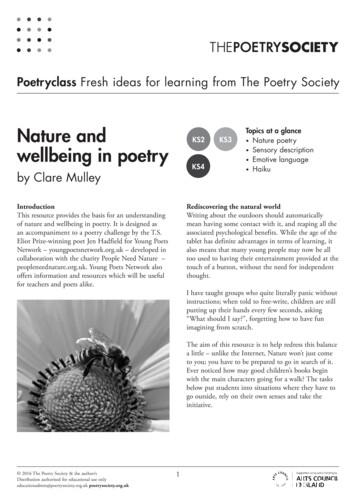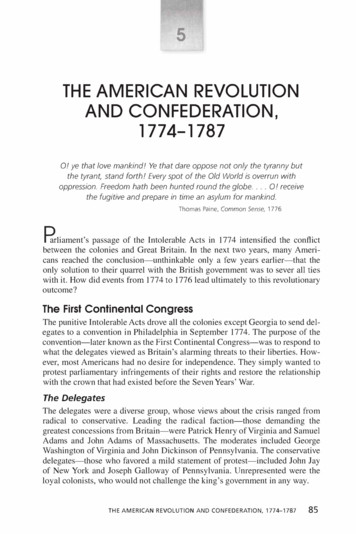Poetry Unit - Missgbrown.weebly
PoetryUnitName
Across3. a five-line poem4. poetry without specific rhyme patterns6. a Japanese, 17-syllable poem7. a literary genre written in verse9. a group of lines of poetry10. pictures formed in the mind; thingsimaginedDown1. words without serious meaning2. a form of humorous nonsense versefive lines long5. words that sound alike8. a specific pattern of stressed andunstressed syllablesWORD NQUAINFREE VERSESTANZAUnscramble each of the clue words.Take the letters that appear inboxes and unscramble them for the final message.S/V
QuatrainThe Quatrain is a poetic formWith rules to which you must conform.It has four lines and a rhyming pattern,Choose any subject, from frogs to Saturn!The dragon descended from the skies,With fierce fire in its eyes,It glared at me and I started to run,But all it wanted was to have some ins are 4-line poems. Notice that in the examples above that a quatrain has the rhyming pattern: AABB.However, quatrains can also have the rhyme pattern ABAB or simply AAAA.Write three quatrains of your own, one each for each of the rhyming patterns.AABBABABAAAASK1
CinquainCinquainStrict, Structured,Creating, Expressing, RevealingChallenging to write correctly,Poem.DragonPowerful, MajesticSoaring, Fighting, Fire-breathing,Love to meet one,Beast.MouseCute, Mischievous,Squeaking, Scurrying, ScamperingI think it’s ***The cinquain gets its name from the fact that it is a poem with five lines. Cinquains have a single subject, andfollow a particular set of rules to talk about that subject.Line 1:Line 2:Line 3:Line 4:Line 5:one word – nountwo adjectives describing the nounthree verbs for the noun (usually ending in “ing”)four words expressing a feeling about the nounone word – synonym for the nounWrite two cinquains of your own.SK2
Concrete PoemConcrete poems are also sometimes called shape poems. They are written in such a way that the words form anactual picture. The words of the poem are in some way about the subject of the picture they create.
Now that you’ve seen some examples of concrete poems, create two of your own.SK3
HaikuHaiku are icebergs:Three lines floating on the page,The rest unwritten.Evening’s ornamentThe golden medallionOf the setting sun.When you write HaikuRemember, freeze a momentLet it live in u is a form of Japanese poetry. Since haiku are so short and structured, not a word can be wasted, and thewords that are written need to hint at much more than they actually say.The haiku is based on syllables. A haiku must have a total of seventeen syllables in the following order:Line 1: 5 syllablesLine 2: 7 syllablesLine 3: 5 syllablesHaiku traditionally are about nature and natural things. However, they can also be about feelings, moods, andemotions. Haiku can even be about whatever you would like. Typically, haiku do not rhyme.Write three haiku of your own. Be sure they follow the syllable pattern given.SK4
************************A diamante poem compares two things that are the opposite of each other. Look at the examples above. Youcan see that the poem gets its name from its diamond shape. Diamante poems are written according to veryspecific rules. They are as follows:Line 1:Line 2:Line 3:Line 4:nountwo adjectives describing the nounthree verbs for the noun (usually ending in “ing”)two adjectives describing the noun on Line 1, and then two adjectives that a describe a noun that is theopposite of the noun on Line 1Line 5: three verbs for the opposite noun (again, usually ending in “ing”)Line 6: two adjectives that describe the opposite nounLine 7: a noun that is the opposite of the noun on Line 1The top half of the poem deals with the first noun, while the bottom half of the poem deals with its gAngryTwistingRedDryMeltingHotFireSometimes it’s easiest to write a diamante poem in this order:Line 1, thenLine 7, thenLine 2, thenWhen writing the poem, you should arrange theLine 6, thenwords on each line so that the overall poem is inLine 3, thenthe shape of a diamond.Line 5, and finallyLine 4Now that you’ve seen some examples of diamante poems, create two of your own.
SK5
LimerickThere was an old man with a beard,Who said, “It is just as I feared!Two owls and a hen,Four larks and a wren,Have all built their nests in my beard.”There once was a teacher named GrayWho said to his students one day,“Now you have until one,Get a limerick done.”The class groaned the hour *********************************************The limerick is a form of light verse, usually composed of five lines arranged in the rhyming pattern ofAABBA. Lines 1, 2, and 5 are longer than lines 3 and 4, often with a syllable pattern of 8, 8, 5, 5, 8. Each linehas an alternating rhythm of stressed and unstressed syllables. Line 1 usually starts with the words “There wasan” or “There once was a”.Limericks are humorous, witty, ironic, and sometimes nonsensical. They are often used to make fun of politics,religion, convention, human mannerisms, or important people. At other times, they are just simply funny.Write two limericks of your own.SK6
Free VerseFree Verseis poetry without rhymeand no form to limit you.You are free to createbeautiful picturesto share with us.Feeling flows freely,poetic, and meaningful,perfect,just the way it is.Soaring on warm winds,seeing the land belowlike a postage stamp.Knowing that with one breathI can set the fields on fireand burn away allhuman contaminationfrom the Earth.I lovebeing a e verse is exactly that – a poem that is written with total freedom. It does not have to rhyme (although it can,if you want). It does not have a set number of lines or syllables. You simply write what you want and stopwhen you’re done. Remember, though, that poetry is a shorter way of expressing ideas differently than younormally do.Write two free verses of your own.SK7
WetWet wet wetthe world of melting winter,icicles weeping themselves awayon the eaveslittle brown rivers streamingdown the roadnibblingat the edges of the tired snow,all puddled mudnot a dry place to puta booted foot,everythingdrippinggushingslushingslippingand listen to that brook,rushinglike a puppy loosed from its leash.-Lillian MooreWrite a paragraph explaining what the author is sayingin this poem. Be specific, and use phrases from thepoem to support your explanation.SK8
I’m ThankfulI’m thankful for my baseball bat,I cracked it yesterday.I’m thankful for my checker set,I haven’t learned to play.I’m thankful for my mittens,One is missing in the snow.I’m thankful for my hamsters,They escaped a month ago.I’m thankful for my basketball,It’s sprung another leak.I’m thankful for my parakeet,It bit me twice last week.I’m thankful for my bicycle,I crashed into a tree.I’m thankful for my roller skates,I fell and scraped my knee.I’m thankful for my model plane,It’s short a dozen parts.I’m thankful for my target game,I’m sure I’ll find the darts.I’m thankful for my bathing suit,It came off in the river.I’m thankful for so many things,except, of course, for LIVER!!-Jack his poem has a sarcastic tone to it. Using a complete, correct sentence, tell what makes it sarcastic.Now, write a short sarcastic poem of your own.SK9
Homework! Oh, Homework!Homework! Oh, Homework!I hate you! You stink!I wish I could wash youaway in the sink,if only a bombwould explode you to bits.Homework! Oh, Homework!You’re giving me fits.I’d rather take bathswith a man-eating shark,or wrestle a lionalone in the dark,eat spinach and liver,pet ten procupines,than tackle the homeworkmy teacher assigns.Homework! Oh, Homework!You’re last on my list,I simply can’t seewhy you even exist,if you just disappearedit would tickle me pink.Homework! Oh, Homework!I hate you! You stink!-Jack *************************************************A great feeling of dislike is very apparent by this author about homework. How do you feel about homework?Now, pretend you are a teacher. Write a paragraph describing what you would do to students who refuse to dohomework.SK10
Oh, Homework! You’re giving me fits. my teacher assigns. I hate you! You stink! -Jack Prelutsky ***** A great feeling of dislike is very apparent by this author about homework. How do you feel about homework? _ _ Now, pretend you are a teacher. Write a paragraph describing what you would do to students who refuse to do homework.
Laila Ragab Marlena Rasmussen Prathamesh Sabarinath Lia Schwalje Molly Van Wyk POETRY 3 STORIES 27 BURSTS 31 OF CREATIVITY Inside this issue: GRANT SCHOOL LITERARY MAGAZINE . POETRY Page 3 By: Laila Ragab. POETRY Page 4 . POETRY Page 5 . POETRY Page 6 . POETRY Page 7 . Page 8 . POETRY Page 9 . POETRY Page 10 . POETRY Page 11 . POETRY Page 12 .
Poetry Texts Structure and features of poetry texts PURPOSE Poetry captures the essence of an object, feeling or thought. Poetry for children should reflect the emotions of childhood, making students feel sensory experiences to an intensified degree and satisfying their natural response to rhythm. FORMS OF POETRY Lyric poetry
affirmed that poetry should be shared every day—meshing with every area of the curriculum. To spark a love of poetry, to bring poetry into children’s lives in a meaningful, unforced way is one of the best gifts we can give. Reading, writing, collecting, and sharing poetry is my passion. The power of poetry forever mystifies me, for so much .
2.6.1 The Characteristics of English Poetry 19 2.6.2 The Importance of Poetry in the Classroom 21 2.6.3 Considerations and Principles of choosing an Educational Poetry 26 2.6.4 Strategies for Teaching Poetry in the Classroom 27 2.7 The Impact of Using Poetry on Devel
Poetryclass Fresh ideas for learning from The Poetry Society 1 Nature and wellbeing in poetry by Clare Mulley Introduction This resource provides the basis for an understanding of nature and wellbeing in poetry. It is designed as an accompaniment to a poetry challenge by the T
ESSENTIALS IN LITERATURE LEVEL 9: SAMPLE POETRY POETRY: LECTURE Day 1 - Elements of Poetry, Poetry Structure Day 2 - Sound Devices, Other Elements of Poetry Day 3 - Figurative Language DREAMS Day 1 - Meet the Author, Making Life's Connections Day 2 - Access the Backdrop, Analyzing Figurative Language: Metaphor, Elements of Poetry: Mood and Tone, Analyzing Figurative Language:
Trigonometry Unit 4 Unit 4 WB Unit 4 Unit 4 5 Free Particle Interactions: Weight and Friction Unit 5 Unit 5 ZA-Chapter 3 pp. 39-57 pp. 103-106 WB Unit 5 Unit 5 6 Constant Force Particle: Acceleration Unit 6 Unit 6 and ZA-Chapter 3 pp. 57-72 WB Unit 6 Parts C&B 6 Constant Force Particle: Acceleration Unit 6 Unit 6 and WB Unit 6 Unit 6
THE AMERICAN REVOLUTION AND CONFEDERATION, 1774-1787 87 . Thomas Paine, a recent English imntigrant to the colonies, argued strongly for what until then had been considered a radical idea. Entitled Common Sense, Paine's essay argued in clear and forceful language for the colonies becoming independent states and breaking all political ties with the British monarchy. Paine argued that it was .























